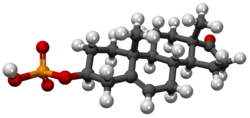Dehydroepiandrosterone sulfate
 |
|
 |
|
| Names | |
|---|---|
|
IUPAC name
[(3S,8R,9S,10R,13S,14S)-10,13-Dimethyl-17-oxo-1,2,3,4,7,8,9,11,12,14,15,16-dodecahydrocyclopenta[a]phenanthren-3-yl] hydrogen sulfate
|
|
| Other names
Prasterone sulfate
|
|
| Identifiers | |
|
651-48-9 |
|
| 3D model (Jmol) | Interactive image |
| Abbreviations | DHEAS |
| ChemSpider |
12074 |
| PubChem | 12594 |
|
|
|
|
| Properties | |
| C19H28O5S | |
| Molar mass | 368.49 g/mol |
|
Except where otherwise noted, data are given for materials in their standard state (at 25 °C [77 °F], 100 kPa).
|
|
|
|
|
| Infobox references | |
Dehydroepiandrosterone sulfate (DHEA-S), also known as prasterone sulfate, is a naturally occurring, endogenous androstane steroid and neurosteroid and the 3β-sulfate ester of dehydroepiandrosterone (DHEA).
As the sodium salt, prasterone sodium sulfate, DHEA-S is used as a pharmaceutical drug in Japan in the treatment of insufficient cervical ripening and cervical dilation during childbirth.
Dehydroepiandrosterone sulfate is produced by the addition of a sulfate group, catalyzed by the sulfotransferase enzymes SULT1A1 and SULT1E1, which also produce estrone sulfate from estrone. DHEA sulfate can also be back-converted to DHEA through the action of steroid sulfatase.
In the zona reticularis layer of the adrenal cortex, DHEA-sulfate is generated by SULT2A1. This layer of the adrenal cortex is thought to be the primary source of serum DHEA-sulfate. DHEA sulfate levels decline as a person ages as the reticularis layer diminishes in size.
Dehydroepiandrosterone sulfate levels above 1890 micromol/L or 700-800 µg/dL are highly suggestive of adrenal dysfunction because DHEA-S is made exclusively by the adrenal glands. Presence of DHEA-S is therefore used to rule out ovarian or testicular origin of excess androgen.
...
Wikipedia
